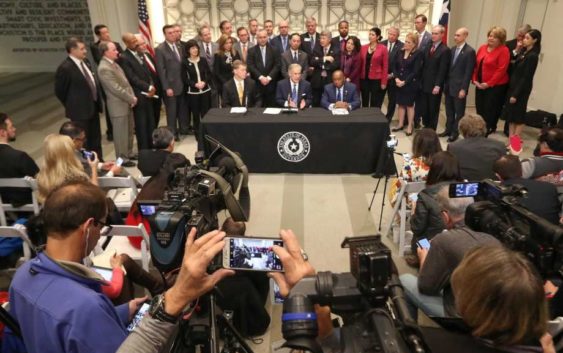- Houston Cougars take on A&M Aggies in charity exhibition game supporting Hurricane Beryl relief
- Hurricane Helene donations delivered to Avery County for Share the Warmth campaign
- Old Crow Medicine Show founder talks music, hurricane relief and this weekend's big benefit show
- IV fluid shortage caused by hurricane to last for months
- 'It financially annihilated us': Pregnant mother displaced for 2nd time after western NC floods
Report on Hurricane Harvey response finds plenty of room for improvement

-
Gov. Greg Abbott (c), Mayor Sylvester Turner (r) and Nim Kidd, Chief of Texas Emergency Management announced funding for flood relief and prevention Tuesday, Feb. 13, 2018, in Houston. ( Steve Gonzales / Houston Chronicle )
Gov. Greg Abbott (c), Mayor Sylvester Turner (r) and Nim Kidd, Chief of Texas Emergency Management announced funding for flood relief and prevention Tuesday, Feb. 13, 2018, in Houston. ( Steve Gonzales /
Photo: Steve Gonzales, Staff Photographer / Houston Chronicle
Gov. Greg Abbott (c), Mayor Sylvester Turner (r) and Nim Kidd, Chief of Texas Emergency Management announced funding for flood relief and prevention Tuesday, Feb. 13, 2018, in Houston. ( Steve Gonzales / Houston Chronicle )
Gov. Greg Abbott (c), Mayor Sylvester Turner (r) and Nim Kidd, Chief of Texas Emergency Management announced funding for flood relief and prevention Tuesday, Feb. 13, 2018, in Houston. ( Steve Gonzales /
Photo: Steve Gonzales, Staff Photographer / Houston Chronicle
A commission created by Gov. Greg Abbott after Hurricane Harvey released a report on Thursday that details more than 50 ways to better prepare Texas for future storms and other natural disasters.
Beside making yet another case for an admittedly expensive coastal spine system to protect Galveston Bay from catastrophic storm surge, the Governor’s Commission to Rebuild Texas calls for better rules for contracting debris removal, more training of local officials on disaster response practices, less paperwork for victims of natural disasters who need aid and an improved radio system for emergency responders in the field.
“This report provides strategies to better prepare and recover from future hurricanes, flooding, as well as other natural disasters,” Abbott said at a press conference announcing the report.
By far the costliest potential item is building a coastal spine system, which would need Congressional approval and funding. The so-called “Ike Dike” would be a 70-mile-long coastal barrier that could cost as much as $31 billion, according to some estimates. In the report released Thursday, one section notes that while the cost is high, it would still be less than the amount of money saved annually by protecting the state from property loss and damage.
John Sharp, the Texas A&M University System Chancellor who led the Governor’s commission, said another key to disaster planning is making sure local governments have people trained on how to respond, something that can be an issue in smaller counties.
“Part of what this report is about is making sure every single county in the state of Texas, there is someone or a group of people who are fully trained on disasters,” Sharp said.
Another major issue after Harvey was debris removal. The Federal Emergency Management Agency has estimated that Harvey produced more than 13 million cubic yards of debris. While it took weeks to remove debris in some communities, it took months in others as local officials battled with contractors hired to pick up the debris, or struggled to find one to do the work.
The report calls for creating a “model contract” requiring contractors to make enough passes to pick up all the debris, something that didn’t always happen after Harvey. The state could also vet contractors to give local communities a list of potential businesses to reach out to when a hurricane hits, the report states.
Some issues, Sharp says, require coordinating with federal agencies like FEMA — such as cutting the red tape for disaster victims who need help.
“We think it probably makes sense for disaster victims to fill out one application for disaster relief instead of half a dozen applications for disaster relief,” Sharp said.
A more expensive issue to tackle is radio communications. The report states that different response teams often could not talk to one another because they didn’t have radio systems that allowed interagency communication.
But the report acknowledges fixing that problem across Texas could cost $813 million.
One recommendation in the report is already moving forward. The report calls for unifying functions of the State Department of Emergency Management with the Texas A&M University System, which already has a number of emergency management functions, like Texas Task Force 1 and Task Force 2, which do search and rescue operations.
Abbott said work has already started to make that happen. He said the Texas Division of Emergency Management will now operate within The Texas A&M University System. The current leader of the Division of Emergency Management, Nim Kidd, will continue to run the agency but will also be a vice chancellor of the A&M System.
jeremy.wallace@chron.com